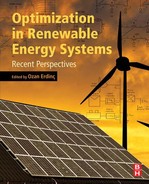Book Description
Optimization in Renewable Energy Systems: Recent Perspectives covers all major areas where optimization techniques have been applied to reduce uncertainty or improve results in renewable energy systems (RES).
Production of power with RES is highly variable and unpredictable, leading to the need for optimization-based planning and operation in order to maximize economies while sustaining performance.
This self-contained book begins with an introduction to optimization, then covers a wide range of applications in both large and small scale operations, including optimum operation of electric power systems with large penetration of RES, power forecasting, transmission system planning, and DG sizing and siting for distribution and end-user premises.
This book is an excellent choice for energy engineers, researchers, system operators, system regulators, and graduate students.
- Provides chapters written by experts in the field
- Goes beyond forecasting to apply optimization techniques to a wide variety of renewable energy system issues, from large scale to relatively small scale systems
- Provides accompanying computer code for related chapters
